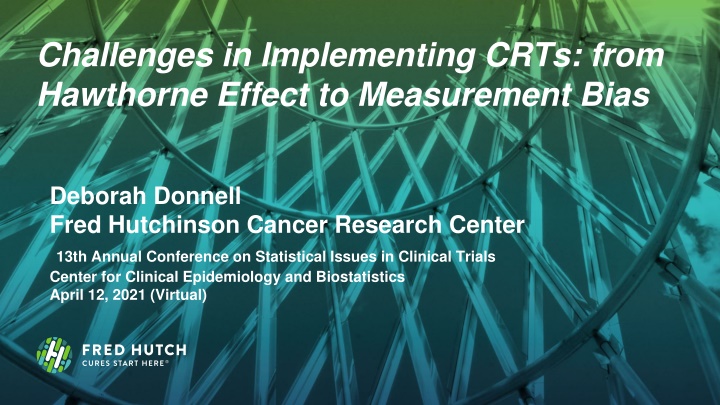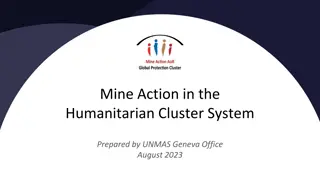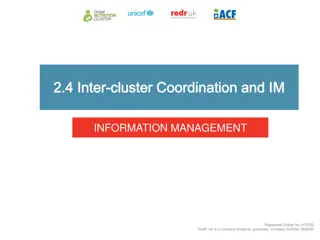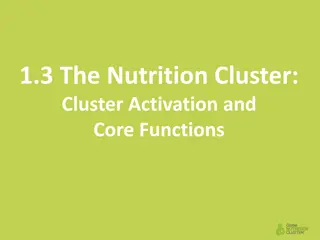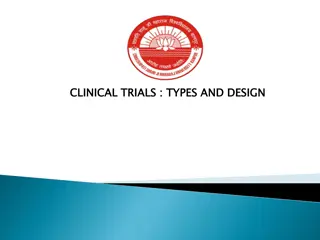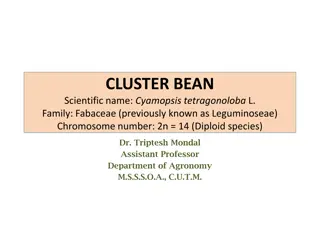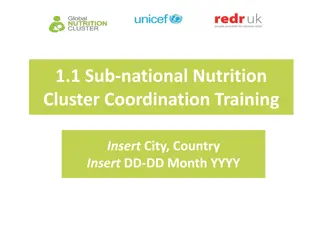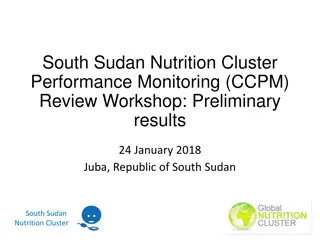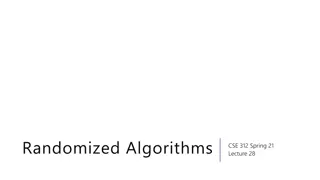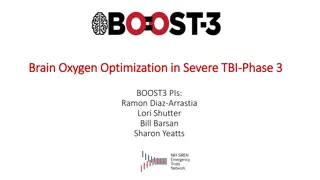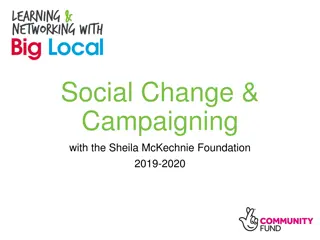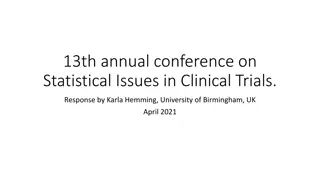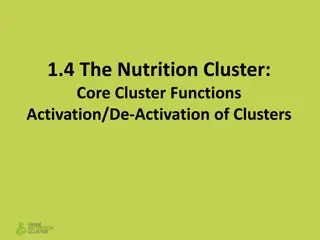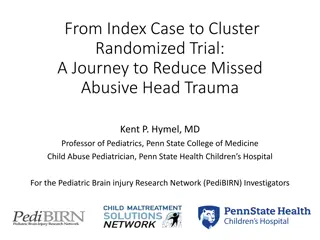Challenges in Implementing Cluster Randomized Trials
This content discusses challenges in implementing Cluster Randomized Trials (CRTs) addressing issues such as the Hawthorne Effect and Measurement Bias. It also highlights lessons learned from different CRTs and the design and evaluation features of interventions. Furthermore, it explores projects like HPTN 043 and Project Accept, focusing on the impact of mobilized HIV testing and financial incentives on HIV incidence and viral suppression.
Download Presentation

Please find below an Image/Link to download the presentation.
The content on the website is provided AS IS for your information and personal use only. It may not be sold, licensed, or shared on other websites without obtaining consent from the author.If you encounter any issues during the download, it is possible that the publisher has removed the file from their server.
You are allowed to download the files provided on this website for personal or commercial use, subject to the condition that they are used lawfully. All files are the property of their respective owners.
The content on the website is provided AS IS for your information and personal use only. It may not be sold, licensed, or shared on other websites without obtaining consent from the author.
E N D
Presentation Transcript
Challenges in Implementing CRTs: from Hawthorne Effect to Measurement Bias Deborah Donnell Fred Hutchinson Cancer Research Center 13th Annual Conference on Statistical Issues in Clinical Trials Center for Clinical Epidemiology and Biostatistics April 12, 2021 (Virtual)
Lessons learned from three different cluster randomized trials 1
Design and Evaluation features How is the intervention implemented and delivered? Cluster randomized implies intervention implemented or delivered to an entire (target group in a) cluster Cluster Who receives the intervention? High coverage important for impact Benefit Intervention Target Who benefits from the intervention? Defines options for measuring impact Evaluation of intervention impact Randomization Evaluation plan Evaluation realities Intervention Coverage 2
HPTN 043: Project Accept (2001 2011) Impact of Mobilized HIV Testing, Support, and Access to Services on HIV incidence Community-based VCT (N = 24 communities) Standard VCT (N = 24 communities) Clinic-based VCT Standard VCT services provided in that community Four peri-urban locations: 34 communities Tanzania: Zimbabwe: Vulindlela, S Africa: 4 pairs Soweto, S Africa: 4 pairs Community preparation, outreach Mobile VCT: 36 months Post-test support services Stigma-reduction skills training Coping effectiveness training Ongoing counseling 5 pairs 4 pairs 3 Van Rooyen et al, AIDS and Behavior, 2012 Sweat et al, Lancet HIV, 2011
Project Accept : Primary result Change in Incidence 40 35 Evaluated HIV in ~46,000 individuals ages 18-32 Risk of recent infection reduced by 14% (95%CI 0.2%-0.27) p = 0.08 Number of Recent infections 30 25 20 15 10 5 Coates et al, Lancet HIV, 2014 0 4 Intervention SOC
HPTN 065: TLC-Plus (2010-2013) FINANCIAL INCENTIVES Care Sites 19 10 9 Financial incentives offered for 2 years. Impact of Financial Incentives on Viral Suppression amongst PLWH HIV test site randomization balanced by: Size of HIV care site s HIV-positive patient case load Proportion of HIV-positive patients with VL suppression at baseline 19 Care Sites 20 10 20 Sites NYC 10 19 Sites Washington D.C. STANDARD OF CARE
TLC-Plus: Primary result - Change in Viral Suppression Average patients in care per site = 500 Increase in probability of viral suppression FI vs SOC = 3.8% (95%CI: 0.7%, 6.8%) p = 0.01 Blue line : Baseline Viral Suppression Green = increase, red = decrease in viral suppression Width = population size Sites within each arm ordered by baseline VS El Sadr Jet al, AMA 2017
HPTN 071: PopART (2012 2018) Impact of Household-based Universal HIV Testing and Universal ART on HIV incidence 21 Communities Arm A Arm B Arm C 7 per arm in matched triplets + SOC ART + Universal ART + SOC ART + SOC HIV Test 12 in Zambia 9 in S Africa 3 years of intervention 7
PopART : Primary result Impact on HIV incidence 3 3 7% reduction p = 0.51 30% reduction p = 0.006 Incidence (per 100 Person-Years) Measured HIV in cohort of 48,000 participants 4 6 4 6 5 5 5 4 2 2 5 1 2 3 3 2 2 6 3 3 6 2 4 1 1 1 1 1 7 7 7 7 0 0 Arm A Arm C Arm B Arm C 10 30 20 40 Z Triplet1 SA Triplet5 Z Triplet2 SA Triplet6 Z Triplet3 SA Triplet7 Z Triplet4 Hayes, NEJM 2019 Triplets Events
Design of intervention evaluation 9
Randomization: De-risking between cluster variance Four different settings in three countries 38 communities (17 pairs) Multiple settings in two countries 21 communities (7 triplets) Multiple clinics in two cities 39 clinics Randomization method Paired communities within each location based on socio-demographic, cultural, and infrastructure characteristics determined from formative research Chirowodza J Community Psychol. 2009 Random allocation within each pair (unrestricted) Randomization method Triplets grouped by location Random allocation of arms within triplet Randomization method Unmatched Stratified by city 1:1 randomization within each city Restricted randomization to balance: Size of community (intervention delivery) HIV prevalence (incidence correlate) ART uptake (intervention baseline) Restricted randomization to balance: Clinic patient volume Baseline proportion clinic patients virally suppressed Matching: 17 vs 38 observations Among all possible allocation select 10,000 with best balance; select 1 at random Among all possible allocations select 5000 with best balance by arm; select 1 at random 10
Intervention intended mechanisms: primary outcome Intervention implementation : HIV testing in the community using mobile vans Post test support Intervention implementation: Household based implementation of universal HIV testing for all adults in the community HIV positive linked to ART at clinic Intervention goal and coverage Increase knowledge of HIV-infected in all adults All HIV-infected on treatment Coverage: All (HIV+) adults reached Impact goal Fewer infections in HIV uninfected HIgher viral suppression in HIV+ Primary outcome HIV incidence in 18-44 year olds Viral suppression in HIV-infected Intervention implementation Clinics implement financial incentives Individuals receive quarterly financial incentive if virally suppressed Intervention goal and coverage Increase knowledge of HIV in all adults Coverage: all adults who accept test Uptake goal All HIV-infected patients in care Coverage: HIV+ receiving incentives Impact goal More clinic patients on ART with consistent viral suppression Impact goal Fewer infections in HIV uninfected Primary outcome Viral suppression in HIV-infected in care Primary Outcome HIV incidence in 18-32 year olds 11
Primary Outcome Measurement accept Challenge: No activity in SOC communities Measuring longtitudinal incidence requires repeated HIV testing Repeated HIV testing is intervention Challenge: No activity in SOC communities Measuring incidence requires repeated HIV testing: first step of intervention for HIV infected Solution Assess incidence longitudinally in representative group Research assessment in only one person per household Offer rapid test (as for intervention); collect sample for research evaluation Assessment design In each community sample ~ 2000 households; enroll 1 adult 18-44 yo Repeat sample collection each year of intervention (4 visits/person) Compare incidence rates between communities in the same triplet Challenge No activity in SOC clinics ~40 independent medical clinics Solution CDC surveillance system systematically accumulates lab data post diagnoses in HIV-infected persons Collaboration with CDC to obtain clinic-aggregated data Assessment design Define viral suppression outcome measure for passive data collection With health departments implement clinic identifiers Compare quarterly clinic-level viral suppression between FI and SOC clinics. Solution Evaluate incidence through end-of- study cross-sectional recency assay in representative group Assessment design After 3 years of intervention In each community, sample ~ 4000 households/community Collect blood sample from all adultsin household 18-32 yo Compare # recent samples between paired communities 12
Realities of ascertainment and measurement 13
Participation in cluster evaluation: Representativeness and risk of ascertainment bias Exempt research: TLC-Plus Theoretically: all tests for all diagnosed PLHV Practically: Link records via name based identifiers: missing data likely not biased. Passive surveillance: Risk of systematic failures that can bias results Research consent: HPTN 071 and HPTN 043 14
Participation in cluster evaluation: Representativeness and risk of ascertainment bias Exempt research: TLC-Plus Theoretically: all tests for all diagnosed PLHV Practically: Failure to link individual records likely not biased. Passive surveillance has risk of systematic failures that can bias results Required research consent: HPTN 071 and HPTN 043 Non-response bias high in household recruitment setting. Project Accept: ~83% participation rate; 46% men PopART: ~ 65% participation rate; 29% men Intervention participation (Coverage) Project Accept : 52-58% participating were men PopART: 56-67% of men; 71-86% of women 16
Evaluation issues: Power Power/Sample size based on equal weight of communities - Enrollment below expectation in 9 of 21 communities Solution: Continue recruitment Open cohort - Add new enrollments during 12 month round - - Retention ~ 70% retained at first annual visit Add new enrollments during 24 month round (Arms A and C only) - Impact on measuring the impact of PopART in the community Assuming treatment-as-prevention is primary mechanism HIV-uninfected person enrolled after one year is experiencing the full benefit of the intervention by living in a community with lower viral load Ameliorate effect of aging of cohort 17
Evaluation issues: Timing Intervention effect - Time for intervention to affect primary outcome; magnitude of effect - Project Accept: Evaluate at the end of the intervention. Assessed change in all persons in household 18-32 yo. - PopART : Change from evaluating all three years to evaluating in only the second and third years (over last 24 months). - TLC-Plus: Evaluation period began 9 months after initiation of financial incentives (over last 15 months) 18
Hawthorne effect in HPTN 071 (PopART) Standard of care Assess impact of participation in HIV+ in the measurement cohort by comparison of rapid test uptake. Increased access to testing Increased detection of undiagnosed HIV+ Increased ART in measurement cohort Little risk to HIV incidence endpoint Test HIV negative Arm A Arm B Uptake of Rapid test: All HIV infected Baseline 1 year 2 year Uptake of Rapid test: HIV infected do not self-report HIV+ Baseline 25% 1 year 19% 2 year 13% Increase in cumulative HIV knowledge (self-report of HIV+ at current or prior visits) Baseline 64% 1 year 75% 2 year 78% 16% 9% 5% 13% 7% 4% 19% 14% 12% 21% 13% 10% 32% 22% 34% Potential impact on viral suppression endpoint in measurement cohort Test HIV-positive 65% 73% 82% 65% 77% 86% 20
Risk of novel approach: Project Accept (2001 2011) Primary endpoint: Cross-sectional recency assay In December 2005, the UNAIDS Reference Group on Estimates, Modeling and Projections issued a statement BED-CEIA assay overestimated HIV incidence by misclassifying a number of individuals with long-term infection as recent infection in cross-sectional settings. Launched a project to validate a recency endpoint (2006-2011) -Achieve joint understanding in laboratory and statistical teams of evaluation problem -Compile a reference library of samples with known length of infection to test algorithms and assays in relevant clades (the basis of the CEPHIA working group) -Lab: assay test results for samples -Statistics: Simulations of assay combinations with lowest bias and highest power Laeyendecker,AIDS 2012 Brookmeyer JAIDS 2013 22
5 years to define endpoint: Evaluation of power Bootstrap simulation to evaluate bias and variance: Three epidemic scenarios 403 combinations of 4 assays 8 entered final assessment Power to detect a 35% decrease in incidence. Estimated intervention effect (RR) 0.631 0.763 0.705 0.653 0.663 Std. error of log estimated RR 0.182 0.109 0.165 0.169 0.157 Coverage of 95% conf. intervals 94.7 57.3 88.8 95.6 93.1 Algorithm 6-month follow-up BED<0.8 AI<40 BED<1.0, AI<80, CD4>200, VL>400 BED<1.2, AI<90, CD4>200, VL>400 Power 70.4% 68.4% 56.5% 69.7% 75.5% BED = BED-CEIA; AI = Avidity index; VL = viral load
Lessons learned Cluster randomized trials have many complex, moving parts Cross-team meetings critical to collectively evaluate progress of all aspects of the trial Team s primary task to stay focused on intervention delivery and coverage Statistician s primary task to stay focused on primary endpoint evaluation Are we measuring the right people, at the optimal time, with high completeness. How are research operations affecting representativeness and power Can we improve/change the measurement approach and still answer the question Expect changes and challenges over the (long) course of operations Creative solutions clearly addressing common goals, working together as a team: balancing operational/intervention and data/statistical perspectives Proactive/timely monitoring of data important for finding problems and unexpected issues early 24
Strengths and challenges of cluster randomized trials It is challenging to effect change across an entire community High coverage x high effectiveness x rapid deployment Set realistic effectiveness expectations Resource intensive trials, designed to demonstrate modest effect sizes Difficult to message success Strengths Choosing to demonstrate population effectiveness informs real- world challenges of scale-up and implementation Trials bring real-world benefits to the communities 25
